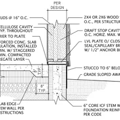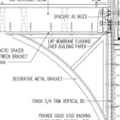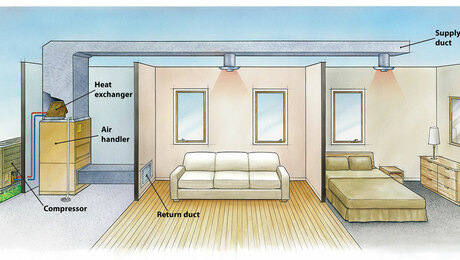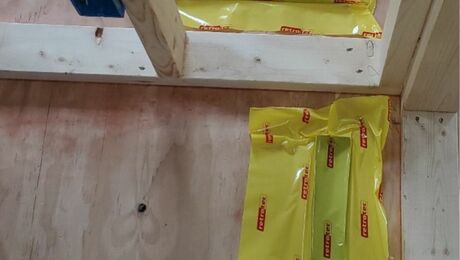Underground home with water problem
We live in an underground home built in the 80’s . Over the years we have removed the top dirt several times and waterproofed with spray tar, bentonite clay, black plastic lined with bentonite and installed a foundation water diversion system. Ground water settles down and seeps into several areas of the roof. We are now ready to try some type of system that would prevent rain and ground water from penetrating all the way to the roof (3 ft) The underground roof system you wrote about seems like a step in the right direction, but the area we need to cover is about 50 x 50 . What would you suggest for the membrane and how deep would you put it? We have a good slope, but would need to excavate to put this in and then cover with dirt and small rock. We live in Illinois and get a lot of rain and snow.
GBA Detail Library
A collection of one thousand construction details organized by climate and house part









Replies
User-7407549,
First of all, can you tell us your name? (I'm Martin.)
Commercial contractors install waterproofing systems for below-grade concrete surfaces all the time. This is not a situation where you need to re-invent the wheel or come up with your own details. Contact a reputable commercial contractor and do it right.
There is no call for materials like black plastic for this application. You need a waterproof membrane akin to roofing, but it has to be rated for burial. Ordinarily, the system would include, from the interior to the exterior, (1) A durable rubber-like membrane, (2) a drainage system consisting of crushed stone or dimple mat, connected to perforated drain pipe, (3) filter fabric to keep fines and silt out of the system.
If this were my house, I might install redundant waterproofing and drainage systems, because you don't want to be digging anything up to make repairs.
You need to contact (a) an engineer and (b) a manufacturer's representative from a reputable waterproofing systems manufacturer like Carlisle. Here is a link: Carlisle waterproofing systems.
Thank you for the reply Martin. My name is Arlene . I looked at Carlisle . It appears that the system they use is applied to the original structure. We have excavated and had a company apply bentonite clay to the concrete structure, but that apparently was not sufficient. We do not have membrane on the concrete. We really don't want to take all the dirt off all the way to the concrete this time and were hoping to find a way to put a layer of membrane about a foot down that would prevent most of the ground water from finding its way to the concrete shell of the house. Our original builder tried to fix it a couple of times and it still has problems.
Arlene,
Your added information does not change my advice. This sentence says it all: "Our original builder tried to fix it a couple of times and it still has problems."
Bentonite is a clay, usually injected as a slurry. It’s used like an underground grout, mostly to hold things in place. It’s not generally considered to be a waterproofing material. Bentonite can also we washed away by flowing water (what we have to sometimes do to clear storm drains after my outdoor crews let the slurry run down the road).
What you need is a specialized contractor as Martin has suggested. You have an application that most contractors won’t be familiar with, so they won’t know how to make a proper repair.
Bill
Polyethylene works quite well for diverting near surface water with little leakage. EPDM (much more expensive) can be made completely watertight, even when level. Make it about 75'x75' and make sure that it's very flat with plenty of slope everywhere. Use some gravel cover to allow the water to move off freely. Do not simply apply principals intended for waterproofing underground vertical walls or underground floors.
Your plan is more similar to a lined pond than a roof - you might consult with a pond builder.
Arlene, I'm far from an expert on this, but I suspect Martin is right. Unless you strip to the bare concrete and do it right, it's never going to be right. I'm an architect .... we haven't done underground homes or structures. But we did do one vast dwelling on Martha's Vineyard where the basement floor was several feet below the water table. The entire basement was designed essentially like a ship to resist water pressure from the exterior...we assumed with storm conditions and rising ocean levels that the basement floor could easily be 6 or 7 feet below water. That introduces not only water that drip drips, but water under pressure, something like 350# per square foot at 6'. That required a tremendous amount of concrete and reinforcing steel for a residence (we also had to keep the house from floating). And obviously water pressure and potential penetration at even a couple feet below the water table is an issue. We used a Grace Bituthene system where a membrane was placed under the basement slab, wrapped around the footings and carefully sealed against the wall waterproofing. To date....not a single drop of water.